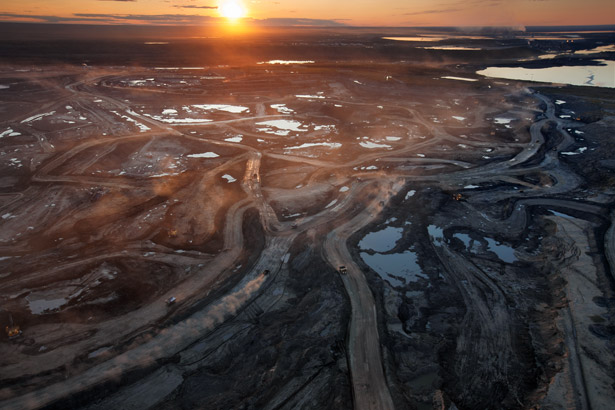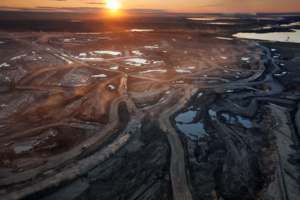This implies involves serious consequences not only for the future of Canada's energy industry, but also for the entire North American region.
In June 2015, the Canadian Association of Petroleum Producers (CAPP) has changed downwards its forecast for production of up to 2030 to 5.3 million barrels of oil per day.
A year earlier, the association predicted that Canada would be able to produce 6.4 million barrels per day by 2030. In comparison, it was producing 3.7 million barrels per day in 2014.
Most experts agree that the prospects for the capital-intensive oil sands are quite gloomy, even loss-making, at a price of $ 45-60 per barrel. However, production continues to grow.
Of course, the capital-intensive operations, such as production from the oil sands, are very expensive – even closure of the extraction is pricey there. Operators are in limbo, waiting for the prices to go up.
Aftermath for Canada should not be underestimated. According to some assessments, the country's oil reserves reach 339 billion barrels, while the oil sands account for about 90%.
The Canadian dollar is at a 10-year low, which significantly softens the blow on exporters in the short term, but long term effects are much less rosy.
Implementations of projects are delayed, and many experts doubt that production from the oil sands has any future.
Peter Tertzakian of ARC Financial tells in an interview with the Alberta Oil Magazine that the era of mega-projects in the oil sands is gone.
In Alberta, about 1 out of 16 jobs are related to the energy sector. According to the National Energy Authority, oil and bitumen brought $ 70 billion in 2014to the budget of Canada.
Perhaps, he says, new projects will simply adapt to become more flexible and will focus more on values rather than on quantity. US shale producers have succeeded using this approach, the analyst says.
Companies working in the oil sands, is already feeling the effects of the weakening of the macroeconomic situation and the volatility of the world oil market.
In August, Moody downgraded Canadian Oil Sands Ltd to "Baa3", which is only one step higher than "risky" rating.
Canadian Oil Sands owns a 36.74% interest in Syncrude, which is one of the most significant players in the market of production at oil sands. This negative outlook is bad for the industry as a whole.
If production from the oil sands in Canada is growing, then where will all this oil go?
Currently, Canada sends 99% of its oil exports - and that 2.9 million barrels a day - in the United States. Most of this oil is sent to refiners in the north-east of the country and on the Gulf Coast.
The United States also suffered from an excess in the oil market, as the increase of productivity and efficiency of oil shale mining have helped many companies to stay afloat. Nevertheless, oil production begins to decline even in the United States.
One way to mitigate the effects of excess in the United States is to abolish outdated legislation to ban oil exports.
Lifting of the ban on exports would enable the US to export oil to the world markets, and it makes sense from an economic point of view, according to supporters of this idea. However, this requires some effort, which will take some time, so the prospect is at best medium.
However, the main limiting factor for Canada is the lack of pipeline infrastructure.
The US will continue to consume Canadian oil, but the market is saturated. Canada seeks to expand the supply to Europe and Asia, but it does not have any really effective opportunities to enter these markets.
Keystone XL pipeline, caused stir, has drawn the attention of the press, but this is only part of a broader pattern.
Even if the pipeline was approved, oil production from the oil sands in Canada would exceed its capacity. Instead, Canada aims to improve transport infrastructure in the country.
Energy East Pipeline according to plans will transport 1.1 million barrels of oil from Alberta to refineries in eastern Canada, yet the project ran into opposition in some regions of the country.
Another pipeline - Northern Gateway Pipeline - will transport more than 500 thousand barrels per day to the city of Kitimat, British Columbia. However, as in the case of the Energy East Pipeline, the project has caused a negative reaction from residents and environmentalists of the regions where the construction is planned.
Given the slow pace of infrastructure development and the impact of environmental protection, as well as consultations with the public, there are few alternatives to the oil market in the medium term.
Canada continues to deliver oil by railway, but in the past two years there have been several serious accidents, which clearly showed how risky this way of transportation is.
In the short term, there is no prospect of improvement in infrastructure for Canadian operators working in the oil sands.
However, production from the oil sands was always very risky, even when oil prices were high. Therefore, market volatility will have a much more serious effect on oil production.
In June 2015, the Canadian Association of Petroleum Producers (CAPP) has changed downwards its forecast for production of up to 2030 to 5.3 million barrels of oil per day.
A year earlier, the association predicted that Canada would be able to produce 6.4 million barrels per day by 2030. In comparison, it was producing 3.7 million barrels per day in 2014.
Most experts agree that the prospects for the capital-intensive oil sands are quite gloomy, even loss-making, at a price of $ 45-60 per barrel. However, production continues to grow.
Of course, the capital-intensive operations, such as production from the oil sands, are very expensive – even closure of the extraction is pricey there. Operators are in limbo, waiting for the prices to go up.
Aftermath for Canada should not be underestimated. According to some assessments, the country's oil reserves reach 339 billion barrels, while the oil sands account for about 90%.
The Canadian dollar is at a 10-year low, which significantly softens the blow on exporters in the short term, but long term effects are much less rosy.
Implementations of projects are delayed, and many experts doubt that production from the oil sands has any future.
Peter Tertzakian of ARC Financial tells in an interview with the Alberta Oil Magazine that the era of mega-projects in the oil sands is gone.
In Alberta, about 1 out of 16 jobs are related to the energy sector. According to the National Energy Authority, oil and bitumen brought $ 70 billion in 2014to the budget of Canada.
Perhaps, he says, new projects will simply adapt to become more flexible and will focus more on values rather than on quantity. US shale producers have succeeded using this approach, the analyst says.
Companies working in the oil sands, is already feeling the effects of the weakening of the macroeconomic situation and the volatility of the world oil market.
In August, Moody downgraded Canadian Oil Sands Ltd to "Baa3", which is only one step higher than "risky" rating.
Canadian Oil Sands owns a 36.74% interest in Syncrude, which is one of the most significant players in the market of production at oil sands. This negative outlook is bad for the industry as a whole.
If production from the oil sands in Canada is growing, then where will all this oil go?
Currently, Canada sends 99% of its oil exports - and that 2.9 million barrels a day - in the United States. Most of this oil is sent to refiners in the north-east of the country and on the Gulf Coast.
The United States also suffered from an excess in the oil market, as the increase of productivity and efficiency of oil shale mining have helped many companies to stay afloat. Nevertheless, oil production begins to decline even in the United States.
One way to mitigate the effects of excess in the United States is to abolish outdated legislation to ban oil exports.
Lifting of the ban on exports would enable the US to export oil to the world markets, and it makes sense from an economic point of view, according to supporters of this idea. However, this requires some effort, which will take some time, so the prospect is at best medium.
However, the main limiting factor for Canada is the lack of pipeline infrastructure.
The US will continue to consume Canadian oil, but the market is saturated. Canada seeks to expand the supply to Europe and Asia, but it does not have any really effective opportunities to enter these markets.
Keystone XL pipeline, caused stir, has drawn the attention of the press, but this is only part of a broader pattern.
Even if the pipeline was approved, oil production from the oil sands in Canada would exceed its capacity. Instead, Canada aims to improve transport infrastructure in the country.
Energy East Pipeline according to plans will transport 1.1 million barrels of oil from Alberta to refineries in eastern Canada, yet the project ran into opposition in some regions of the country.
Another pipeline - Northern Gateway Pipeline - will transport more than 500 thousand barrels per day to the city of Kitimat, British Columbia. However, as in the case of the Energy East Pipeline, the project has caused a negative reaction from residents and environmentalists of the regions where the construction is planned.
Given the slow pace of infrastructure development and the impact of environmental protection, as well as consultations with the public, there are few alternatives to the oil market in the medium term.
Canada continues to deliver oil by railway, but in the past two years there have been several serious accidents, which clearly showed how risky this way of transportation is.
In the short term, there is no prospect of improvement in infrastructure for Canadian operators working in the oil sands.
However, production from the oil sands was always very risky, even when oil prices were high. Therefore, market volatility will have a much more serious effect on oil production.






